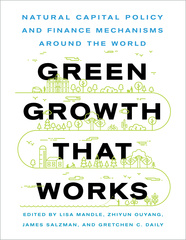
328 pages, 7 x 10
135 figures-illustrations
Paperback
Release Date:02 Dec 2021
ISBN:9781642831351
Pathways to Success
Taking Conservation to Scale in Complex Systems
Island Press
As environmental problems grow larger and more pressing, conservationists have had to adapt. With a shrinking window of time to act, they are turning to broad approaches to combat continental- and global-scale crises of biodiversity loss, invasive species, and climate change. Pathways to Success—the long-awaited successor to the classic volume Measures of Success—is a modern guide to building large-scale transformative programs capable of tackling the complex conservation crises we face today.
In this strikingly illustrated volume, coauthors Nick Salafsky and Richard Margoluis walk readers through fundamental concepts of effective program-level design, helping them to think strategically about project coordination, funding, and stakeholder input. Chapters in the first part of the book look at all aspects of designing and implementing large-scale conservation programs while the second part focuses on how to use data and information to manage, adapt, and learn from program strategies. In addition, the authors offer practical advice for avoiding pitfalls, such as formulaic recipes and simplistic silver-bullet solutions that can trip up otherwise well-intentioned efforts. Abundant graphics help to explain and clarify concepts presented in the text, and a glossary in the back matter defines technical terms for the reader.
Pathways to Success is the definitive guide for conservation program managers and funders who want to increase the scale and effectiveness of their work combating biodiversity loss, climate change, and other pressing environmental issues.
In this strikingly illustrated volume, coauthors Nick Salafsky and Richard Margoluis walk readers through fundamental concepts of effective program-level design, helping them to think strategically about project coordination, funding, and stakeholder input. Chapters in the first part of the book look at all aspects of designing and implementing large-scale conservation programs while the second part focuses on how to use data and information to manage, adapt, and learn from program strategies. In addition, the authors offer practical advice for avoiding pitfalls, such as formulaic recipes and simplistic silver-bullet solutions that can trip up otherwise well-intentioned efforts. Abundant graphics help to explain and clarify concepts presented in the text, and a glossary in the back matter defines technical terms for the reader.
Pathways to Success is the definitive guide for conservation program managers and funders who want to increase the scale and effectiveness of their work combating biodiversity loss, climate change, and other pressing environmental issues.
Given the urgent need for scalable solutions to address today’s global challenges, Pathways to Success transforms good intent into good management practice. It is a fundamental read for all working to put people and planet first.
'Pathways to Success provides a systematic guide to achieve large-scale, environmental conservation. The authors champion flexible, adaptive strategies to tame complex systems. While stressing what they call ‘aluminum' standard’ analytic approaches, their book is the gold standard of guides to environmental transformation.'
Large-scale conservation programs often require policy and societal changes, and the initial theory of change is rarely one hundred percent accurate. Thus, a program must constantly measure and adapt to fit emerging know ledge. This marvelous new book explores this approach and is a wonderful addition that will inform anyone struggling to make changes in large, complex systems.
Nick Salafsky is Executive Director of Foundations of Success, the Product Manager of Miradi Adaptive Management Software, and one of the initial founders of the Conservation Measures Partnership. Over the past two decades he has worked with hundreds of conservation projects and programs around the world on strategic planning, adaptive management, and cross-program learning.
Richard Margoluis is Chief Adaptive Management and Evaluation Officer at the Gordon and Betty Moore Foundation where he and his team support grant-making in environmental conservation, basic science, patient care, and the San Francisco Bay Area. Before joining the Moore Foundation, Richard worked with Nick as codirector of Foundations of Success and was also one of the initial founders of the Conservation Measures Partnership.
Richard Margoluis is Chief Adaptive Management and Evaluation Officer at the Gordon and Betty Moore Foundation where he and his team support grant-making in environmental conservation, basic science, patient care, and the San Francisco Bay Area. Before joining the Moore Foundation, Richard worked with Nick as codirector of Foundations of Success and was also one of the initial founders of the Conservation Measures Partnership.
Foreword
Aileen Lee
Preface
Taking Conservation to Scale in Complex Systems
About This Book
Acknowledgements
Introduction
Focus of This Book
How This Book Is Organized
Overarching Themes
Sources and Further Information
PART I. Designing and Implementing Your Program
Chapter 1. Framing and Assessing the Situation
Clarifying Your Purpose
Understanding the System in Which You Are Working
Developing a Shared Situation Model
Situation Model and Situation Pathway Examples
Sources and Further Information
Chapter 2. Planning Your Strategies
Understanding Your Overall Impact Trajectory
Finding Key Intervention Points in Situation Models
Identifying Candidate Actions
Creating Strategy Pathways to Show Theories of Change
Developing Your Approach for Going to Scale
Determining Your Program’s Investment Approach
Sources and Further Information
Chapter 3. Operationalizing and Implementing Your Program
Setting SMART Goals and Objectives
Analyzing Trade-Offs and Conflict
Turning Your Strategic Plan into an Actionable Work Plan
Assembling a Programmatic Investment Portfolio
Awarding Contracts and Grants That Enable Adaptation
Sources and Further Information
PART II. Using and Expanding Your Evidence Base
Chapter 4. Synthesizing Existing Evidence
Determining Investment in Evidence Based on Your Burden of Proof
Identifying Critical Claims Requiring Evidence
Compiling Evidence Sources and Assessing Claims
Sources and Further Information
Chapter 5. Monitoring and Adapting
Developing Your Monitoring Plan
Monitoring Your Strategy Effectiveness
Defining and Measuring Long-Term Program Success
Analyzing Data and Using the Results to Adapt
Reporting to Your Team and Stakeholders
Exiting Responsibly
Sources and Further Information
Chapter 6. Promoting Collaborative Learning
Contributing to the Global Evidence Base
Developing Collaborative Learning Programs
Building the Discipline of Conservation
Sources and Further Information
Some Final Words
Glossary
Keys to Diagrams Used in This Book
About the Authors
Index
Aileen Lee
Preface
Taking Conservation to Scale in Complex Systems
About This Book
Acknowledgements
Introduction
Focus of This Book
How This Book Is Organized
Overarching Themes
Sources and Further Information
PART I. Designing and Implementing Your Program
Chapter 1. Framing and Assessing the Situation
Clarifying Your Purpose
Understanding the System in Which You Are Working
Developing a Shared Situation Model
Situation Model and Situation Pathway Examples
Sources and Further Information
Chapter 2. Planning Your Strategies
Understanding Your Overall Impact Trajectory
Finding Key Intervention Points in Situation Models
Identifying Candidate Actions
Creating Strategy Pathways to Show Theories of Change
Developing Your Approach for Going to Scale
Determining Your Program’s Investment Approach
Sources and Further Information
Chapter 3. Operationalizing and Implementing Your Program
Setting SMART Goals and Objectives
Analyzing Trade-Offs and Conflict
Turning Your Strategic Plan into an Actionable Work Plan
Assembling a Programmatic Investment Portfolio
Awarding Contracts and Grants That Enable Adaptation
Sources and Further Information
PART II. Using and Expanding Your Evidence Base
Chapter 4. Synthesizing Existing Evidence
Determining Investment in Evidence Based on Your Burden of Proof
Identifying Critical Claims Requiring Evidence
Compiling Evidence Sources and Assessing Claims
Sources and Further Information
Chapter 5. Monitoring and Adapting
Developing Your Monitoring Plan
Monitoring Your Strategy Effectiveness
Defining and Measuring Long-Term Program Success
Analyzing Data and Using the Results to Adapt
Reporting to Your Team and Stakeholders
Exiting Responsibly
Sources and Further Information
Chapter 6. Promoting Collaborative Learning
Contributing to the Global Evidence Base
Developing Collaborative Learning Programs
Building the Discipline of Conservation
Sources and Further Information
Some Final Words
Glossary
Keys to Diagrams Used in This Book
About the Authors
Index






